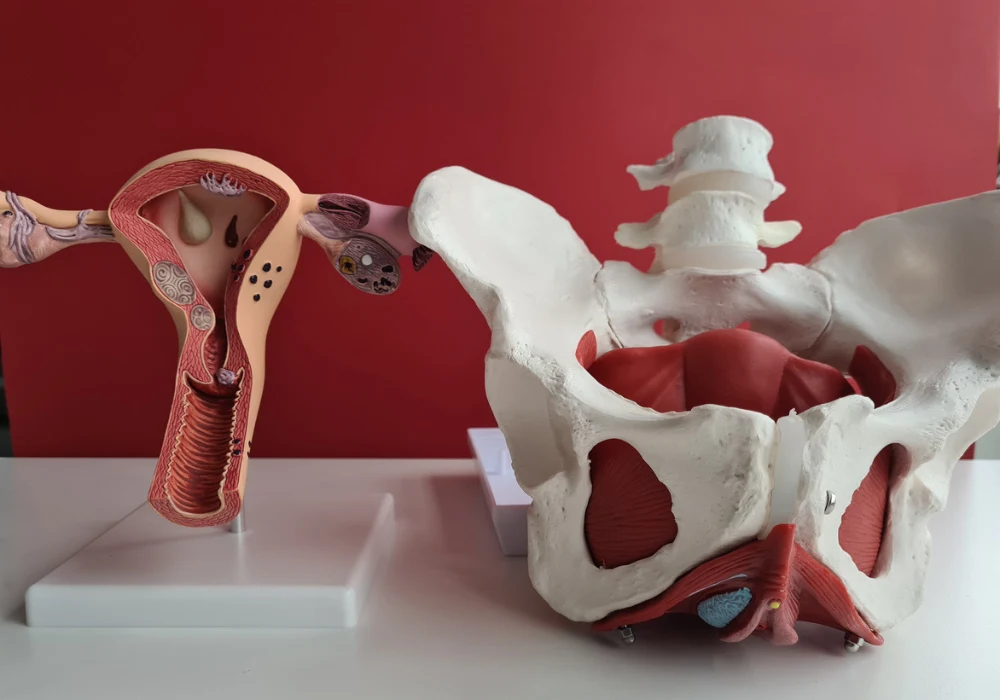Accurate characterisation of ovarian masses remains central to timely treatment decisions and the avoidance of unnecessary surgery. Conventional MRI offers strong soft-tissue contrast yet overlapping appearances between benign and malignant lesions can blur interpretation, particularly for morphologically complex masses. A multi-centre investigation developed an MRI-based radiomics model to categorise ovarian masses and compared its diagnostic performance with the Ovarian-Adnexal Reporting and Data System (O-RADS) and with assessments by junior and senior radiologists. The work examined overall accuracy, head-to-head comparisons and performance in clinically challenging subgroups such as O-RADS 4 alongside tests of robustness across scanner vendors and field strengths. The findings point to quantitative support that may refine preoperative decisions and guide treatment planning.
Multi-centre Radiomics Model and Dataset
The retrospective cohort comprised 497 patients from two hospitals between December 2018 and December 2023, split into training, internal validation and external validation sets of 293, 124 and 80 masses. Benign and malignant cases were balanced overall with 249 benign and 248 malignant lesions. Histopathology following surgery served as the reference standard with borderline tumours grouped as malignant. The mean age was 48.1 years. Lesions were categorised morphologically as solid, cystic-solid or cystic.
MRI examinations used 1.5 T and 3.0 T scanners from two manufacturers with multi-parametric sequences including T2-weighted imaging with and without fat suppression, diffusion weighted imaging with b=1000 s/mm² and ADC maps and contrast-enhanced T1-weighted imaging with one precontrast and three postcontrast series. For patients with multiple adnexal masses the most complex or largest lesion was selected. An experienced reader assigned O-RADS MRI risk scores and two further readers provided independent malignancy likelihood ratings.
Volumes of interest were generated semi-automatically on DWI, ADC, T2WI-FS and contrast-enhanced T1WI then reviewed and adjusted. Image normalisation and resampling preceded feature extraction. Using PyRadiomics, 1,688 features per sequence were extracted spanning shape, first-order intensity, multiple texture families and filtered transforms. Reproducibility testing on 30 cases demonstrated high intra-reader repeatability and moderate inter-reader agreement after which features with intra-reader intraclass correlation coefficients below 0.80 were excluded. A two-stage selection pipeline with minimum redundancy maximum relevance and least absolute shrinkage and selection operator followed by stepwise logistic regression using the Akaike information criterion yielded a multi-sequence radiomics signature. The final model combined DWI, ADC, T2WI-FS and contrast-enhanced T1WI.
Must Read: Node-RADS Improves Nodal Staging in Endometrial Cancer
Head-to-Head Performance Against O-RADS and Radiologists
Across datasets the radiomics model consistently showed strong discrimination between benign and malignant ovarian masses. In training, internal validation and external validation the model achieved areas under the ROC curve of 0.975, 0.962 and 0.939 with balanced sensitivities and specificities. In the external cohort the sensitivity was 0.875 and specificity 0.917.
O-RADS MRI also performed well but at lower levels in external validation with an AUC of 0.862. The junior radiologist achieved an external AUC of 0.802 while the senior radiologist reached 0.886. Statistical comparisons indicated the radiomics model outperformed O-RADS and the junior reader in external validation and was similar to the senior reader. These results held in training and internal validation where the model’s AUCs were significantly higher than O-RADS and both readers except where differences with the senior reader were not significant.
The analysis also addressed a common clinical dilemma: management of O-RADS MRI category 4 where positive predictive value for malignancy is reported to be about 50% and where uncertainty can lead to either unnecessary resection or suboptimal treatment. Within this subgroup of 112 masses the radiomics model achieved an AUC of 0.879, outperforming both junior and senior radiologists. This suggests the model can refine risk within O-RADS 4 and reduce ambiguity in preoperative planning.
Clinical Performance and Practical Considerations
Performance was examined across morphological phenotypes. For solid masses the model reached an AUC of 0.921, significantly higher than O-RADS and both radiologists. For cystic-solid lesions the AUC was 0.975, higher than both readers and similar to O-RADS. For predominantly cystic lesions the AUC was 0.848 with no significant differences against O-RADS or either reader noting that malignant cases were fewer in this subgroup. These findings indicate the greatest gains where morphology is solid or mixed where misclassification risk can be clinically consequential.
Technical generalisability was explored across scanners and field strengths. The model maintained comparable performance at 3.0 T and 1.5 T with AUCs of 0.959 and 0.958 and showed no significant differences between GE and Philips systems in pairwise comparisons. This resilience across platforms supports potential translation into diverse imaging environments and reduces concerns that model behaviour is tied to a single vendor or protocol.
The retrospective design and the two-centre sample may limit broad generalisability although multi-vendor validation mitigates technical heterogeneity. O-RADS assessments were based on non-DCE protocols which may affect direct comparisons with a radiomics signature that incorporates contrast-enhanced features. Subgroup analyses included uneven distributions and a smaller number of malignant cystic lesions. The authors note that future work should prioritise prospective multi-centre validation across diverse populations and consider cost-effectiveness, segmentation time, computational requirements and interoperability with PACS and RIS. Incorporating dynamic contrast-enhanced MRI into both O-RADS and radiomics workflows may also improve concordance with guideline recommendations.
An MRI-based radiomics model integrating diffusion, ADC, T2-weighted fat-suppressed and contrast-enhanced sequences delivered high accuracy for categorising ovarian masses and outperformed O-RADS and a junior radiologist while matching a senior reader in external testing. Its ability to refine risk in O-RADS 4 and to excel for solid and cystic-solid morphologies provides quantitative support that can reduce diagnostic uncertainty and inform treatment decisions. Consistent performance across vendors and field strengths further underscores feasibility for clinical adoption subject to prospective validation and workflow integration.
Source: Insights into Imaging
Image Credit: iStock










